Mendelssohn included examples of the solo and duet in his fifth volume of
Lieder ohne Worte, Op 62, published in 1844 with a dedication to Clara Schumann. Nos 1 and 6, with their singing soprano melodies supported by subdued arpeggiations, exemplify the solo variety, while No 5, which projects a wistful soprano melodic line doubled in thirds, is an example of the duet variety. The third of Mendelssohn’s
Venetianische Gondellieder for piano solo, No 5 is also the only one of the six pieces of Op 62 that he officially titled. Like its predecessors (Op 19 No 6 and Op 30 No 6), it evokes the Venetian lagoons with softly mottled harmonies and a gently flowing accompaniment. But two other pieces of Op 62 were understood by Mendelssohn’s circle to convey extra-musical ideas. No 3, in E minor, framed by solemn fanfare-like chords, became known as the
Trauermarsch, or Funeral March; composed early in 1843, it was likely a musical response to the death of the composer’s mother, Lea, in December 1842. And among the autograph copies of No 6 is one that bears in Mendelssohn’s hand the title
Ein Frühlingslied (‘A Spring Song’), though he suppressed it when Op 62 was published. Nevertheless, that omission did not prevent the piece from entering the classical canon and popular culture alike as the ‘Spring Song’, a title at least validated by some evidence in the composer’s hand, unlike the case of Beethoven’s celebrated ‘Spring’ Violin Sonata, Op 24, the title of which was seemingly invented around the middle of the nineteenth century. As for Op 62 Nos 2 and 4, we have no hard clues about any possible extra-musical significance, but their homophonic textures, which feature block-like chords, suggest that Mendelssohn conceived them as imitations of choral part-songs.
from notes by R Larry Todd © 2016
author of Mendelssohn: A Life in Music, Fanny Hensel: The Other Mendelssohn and, with Marc Moskovitz, Beethoven’s Cello: Five Revolutionary Sonatas and Their World
Mendelssohn inclut des exemples de solo et de duo dans son cinquième volume de
Lieder ohne Worte, op.62, publié en 1844 avec une dédicace à Clara Schumann. Les nos 1 et 6, avec leur mélodies soprano chantantes soutenues par des arpèges contenus, illustrent la variété du solo, alors que la no 5, qui projette une ligne mélodique soprano mélancolique doublée en tierces, est un exemple de la variété du duo. Le no 5, troisième des
Venetianische Gondellieder («Chants de gondoliers vénitiens») pour piano seul de Mendelssohn, est également le seul des six morceaux de l’op.62 auquel il donna officiellement un titre. Comme ses prédécesseurs (op.19 no 6 et op.30 no 6), il évoque les lagunes vénitiennes avec des harmonies douces et floues et un accompagnement qui s’écoule tranquillement. Mais pour les proches de Mendelssohn, deux autres pièces de l’op.62 traduisaient des idées extra musicales. La troisième, en mi mineur, encadrée par des accords solennels dans le style d’une fanfare, prit le titre de
Trauermarsch ou Marche funèbre; composée au début de l’année 1843, c’était probablement une réponse musicale à la mort de la mère du compositeur, Lea, en décembre 1842. Et parmi les exemplaires autographes de la sixième, il y en a un qui porte le titre
Ein Frühlingslied («Une chanson de printemps») de la main de Mendelssohn, mais il le supprima lorsque l’op.62 fut publié. Néanmoins, cette omission n’empêcha pas ce morceau de s’imposer au répertoire classique comme dans la culture populaire sous le titre de «Chanson de printemps», titre au moins validé par certains témoignages de la main du compositeur, contrairement au cas de la célèbre Sonate pour violon et piano «Le Printemps», op.24, de Beethoven, dont le titre fut apparemment inventé vers le milieu du XIXe siècle. Quant à l’op.62 nos 2 et 4, on n’a aucun indice sérieux relatif à une éventuelle signification extra musicale, mais leurs textures homophoniques, qui présentent des accords comparables à des blocs d’accords, suggèrent que Mendelssohn les conçut comme des imitations de chants polyphoniques choraux.
extrait des notes rédigées par R Larry Todd © 2016
auteur de Mendelssohn: A Life in Music, Fanny Hensel: The Other Mendelssohn et, avec Marc Moskovitz, Beethoven’s Cello: Five Revolutionary Sonatas and Their World
Français: Marie-Stella Pâris
Für das fünfte Heft seiner
Lieder ohne Worte, op. 62, komponierte Mendelssohn sowohl Solo-Nummern als auch Duette. Dieser Band, der insgesamt sechs Stücke enthält, wurde 1844 mit einer Widmung an Clara Schumann veröffentlicht. Nr. 1 und 6 repräsentieren mit ihren singenden Sopranmelodien und dezenten begleitenden Arpeggien das Solo-Lied, während Nr. 5 das Duett darstellt, in dem eine wehmütige Melodie in Sopranlage mit Terzdopplung erklingt. Nr. 5 ist zudem das dritte von Mendelssohns
Venetianischen Gondelliedern für Klavier solo und das einzige der sechs Stücke von op. 62, dem er einen offiziellen Titel verlieh. Ebenso wie bei den Vorgängerstücken (op. 19 Nr. 6 und op. 30 Nr. 6) werden auch hier die venezianischen Lagunen mit sanft melierten Harmonien und einer friedlich dahinfließenden Begleitung dargestellt. Bei zwei weiteren Stücken aus op. 62 ging man in Mendelssohns Zirkel jedoch davon aus, dass hier außermusikalische Ideen vermittelt wurden. Nr. 3 in e-Moll, von feierlichen fanfarenartigen Akkorden eingerahmt, wurde als
Trauermarsch bekannt; es war zu Beginn des Jahres 1843 entstanden und ist wohl als musikalische Reaktion auf den Tod seiner Mutter Lea im Dezember 1842 zu verstehen. In seinem Manuskript hatte Mendelssohn Nr. 6 den Titel
Ein Frühlingslied gegeben, den er jedoch in der Druckausgabe wegließ. Trotzdem wurde dieses Stück sowohl im klassischen Kanon als auch in der populären Kultur als „Frühlingslied“ bekannt—wenigstens ist dieser Titel insofern gültig, als dass er in der Handschrift des Komponisten vorliegt, im Gegensatz zu der berühmten „Frühlingssonate“ op. 24 von Beethoven für Violine und Klavier, deren Titel offensichtlich um die Mitte des 19. Jahrhunderts dazu erfunden wurde. Es gibt keine eindeutigen Hinweise auf den außermusikalischen Inhalt von Nr. 2 und 4 aus op. 62, doch deuten die homophonen Strukturen, die Akkordblöcke aufweisen, an, dass Mendelssohn sie offenbar als Imitationen mehrstimmiger Chorlieder aufgefasst hatte.
aus dem Begleittext von R Larry Todd © 2016
Autor von Felix Mendelssohn Bartholdy: Sein Leben, seine Musik, Fanny Hensel: The Other Mendelssohnsowie, zusammen mit Marc Moskovitz, Beethoven’s Cello: Five Revolutionary Sonatas and Their World
Deutsch: Viola Scheffel


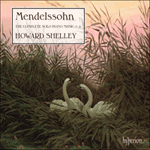 Mendelssohn: The Complete Solo Piano Music, Vol. 4
Mendelssohn: The Complete Solo Piano Music, Vol. 4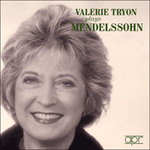 Mendelssohn: Valerie Tryon plays Mendelssohn
Mendelssohn: Valerie Tryon plays Mendelssohn BBC Music Magazine» More
BBC Music Magazine» More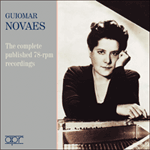 Guiomar Novaes - The complete published 78-rpm recordings
Guiomar Novaes - The complete published 78-rpm recordings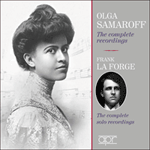 Olga Samaroff & Frank La Forge - The complete recordings
Olga Samaroff & Frank La Forge - The complete recordings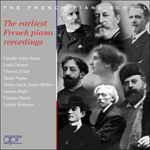 The earliest French piano recordings
The earliest French piano recordings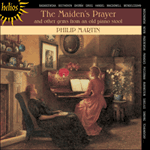 The Maiden's Prayer
The Maiden's Prayer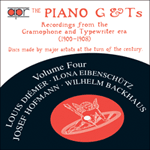 The Piano G & Ts, Vol. 4 - Diémer, Eibenschütz, Hofmann & Backhaus
The Piano G & Ts, Vol. 4 - Diémer, Eibenschütz, Hofmann & Backhaus
